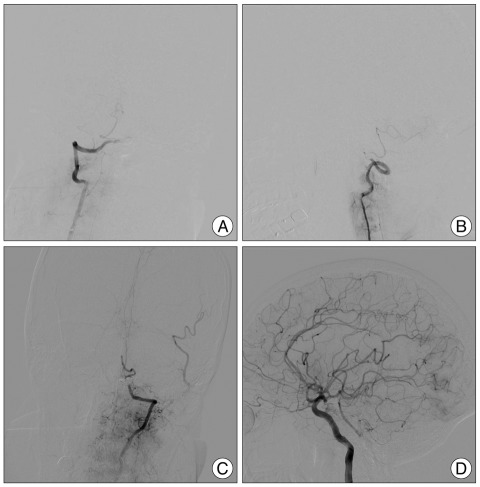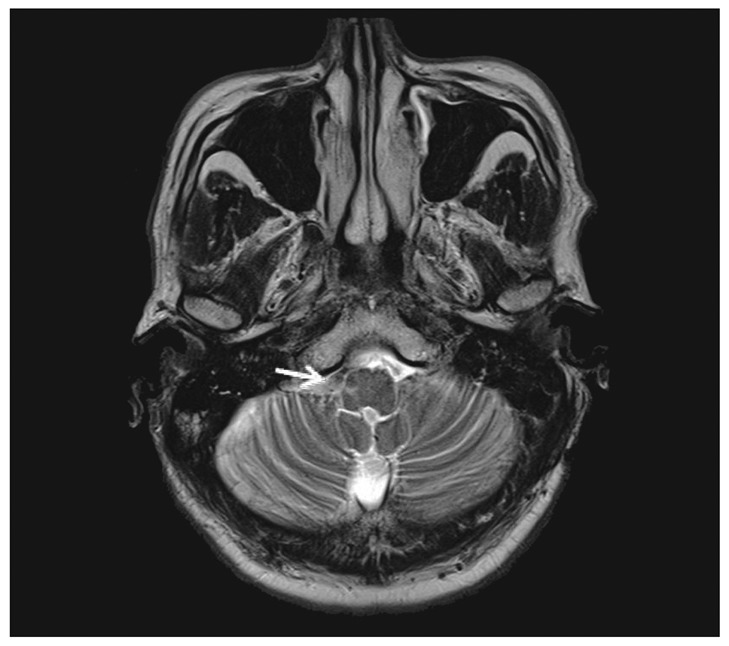J Korean Neurosurg Soc.
2012 Mar;51(3):160-163. 10.3340/jkns.2012.51.3.160.
A Case of Lateral Medullary Infarction after Endovascular Trapping of the Vertebral Artery Dissecting Aneurysm
- Affiliations
-
- 1Department of Neurosurgery, College of Medicine, Ewha Womans University, Seoul, Korea. nshsg@ewha.ac.kr
- KMID: 2018191
- DOI: http://doi.org/10.3340/jkns.2012.51.3.160
Abstract
- We report an unusual case of lateral medullary infarction after successful embolization of the vertebral artery dissecting aneurysm (VADA). A 49-year-old man who had no noteworthy previous medical history was admitted to our hospital with a severe headache. Computed tomography (CT) revealed a subarachnoid hemorrhage, located in the basal cistern and posterior fossa. Cerebral angiography showed a VADA, that did not involve the origin of the posterior inferior cerebellar artery (PICA). We treated this aneurysm via endovascular trapping of the vertebral artery distal to the PICA. After operation, CT revealed post-hemorrhagic hydrocephalus, which we resolved with a permanent ventriculoperitoneal shunt procedure. Postoperatively, the patient experienced transient mild hoarsness and dysphagia. Magnetic resonance image (MRI) showed a small infarction in the right side of the medulla. The patient recovered well, though he still had some residual symptom of dysphagia at discharge. Such an event is uncommon but can be a major clinical concern. Further investigation to reveal risk factors and/or causative mechanisms for the medullary infarction after successful endovascular trapping of the VADA are sorely needed, to minimize such a complication.
MeSH Terms
Figure
Cited by 1 articles
-
A Case of Posterior Inferior Cerebellar Artery Infarction after Cervical Chiropractic Manipulation
Do Kyeun Jeong, Sung-Kyun Hwang
Korean J Neurotrauma. 2018;14(2):159-163. doi: 10.13004/kjnt.2018.14.2.159.
Reference
-
1. Ali MJ, Bendok BR, Tawk RG, Getch CC, Batjer HH. Trapping and revascularization for a dissecting aneurysm of the proximal posteroinferior cerebellar artery : technical case report and review of the literature. Neurosurgery. 2002; 51:258–262. discussion 262-263. PMID: 12182429.2. Dinichert A, Rüfenacht DA, Tribolet N. Dissecting aneurysms of the posterior inferior cerebellar artery : report of four cases and review of the literature. J Clin Neurosci. 2000; 7:515–520. PMID: 11029232.
Article3. Fisher CM, Karnes WE, Kubik CS. Lateral medullary infarction-the pattern of vascular occlusion. J Neuropathol Exp Neurol. 1961; 20:323–379. PMID: 13699936.
Article4. García-García J, Ayo-Martín O, Segura T. Lateral medullary syndrome and ipsilateral hemiplegia (Opalski syndrome) due to left vertebral artery dissection. Arch Neurol. 2009; 66:1574–1575. PMID: 20008668.
Article5. Giannopoulos S, Markoula S, Kosmidou M, Pelidou SH, Kyritsis AP. Lateral medullary ischaemic events in young adults with hypoplastic vertebral artery. J Neurol Neurosurg Psychiatry. 2007; 78:987–989. PMID: 17702781.
Article6. Hamada J, Kai Y, Morioka M, Yano S, Todaka T, Ushio Y. Multimodal treatment of ruptured dissecting aneurysms of the vertebral artery during the acute stage. J Neurosurg. 2003; 99:960–966. PMID: 14705721.
Article7. Iihara K, Sakai N, Murao K, Sakai H, Higashi T, Kogure S, et al. Dissecting aneurysms of the vertebral artery : a management strategy. J Neurosurg. 2002; 97:259–267. PMID: 12186451.8. Iwabuchi S, Yokouchi T, Kimura H, Ueda M, Samejima H. Rupture of a large vertebral artery aneurysm following proximal occlusion. Interv Neuroradiol. 2005; 11:51–58. PMID: 20584435.
Article9. Jao T, Liu HM, Tang SC, Jeng JS. Dissection of the posterior inferior cerebellar artery in a young adult with cerebellar infarct. Acta Neurol Taiwan. 2008; 17:243–247. PMID: 19280868.10. Jeon SG, Kwon do H, Ahn JS, Kwun BD, Choi CG, Jin SC. Detachable coil embolization for saccular posterior inferior cerebellar artery aneurysms. J Korean Neurosurg Soc. 2009; 46:221–225. PMID: 19844622.
Article11. Kakino S, Ogasawara K, Kubo Y, Otawara Y, Tomizuka N, Suzuki M, et al. Treatment of vertebral artery aneurysms with posterior inferior cerebellar artery-posterior inferior cerebellar artery anastomosis combined with parent artery occlusion. Surg Neurol. 2004; 61:185–189. discussion 189. PMID: 14751640.
Article12. Kwon M, Lee JH, Kim JS. Dysphagia in unilateral medullary infarction : lateral vs medial lesions. Neurology. 2005; 65:714–718. PMID: 16157904.
Article13. Lee JM, Kim TS, Joo SP, Yoon W, Choi HY. Endovascular treatment of ruptured dissecting vertebral artery aneurysms--long-term follow-up results, benefits of early embolization, and predictors of outcome. Acta Neurochir (Wien). 2010; 152:1455–1465. PMID: 20467760.
Article14. Lewis SB, Chang DJ, Peace DA, Lafrentz PJ, Day AL. Distal posterior inferior cerebellar artery aneurysms : clinical features and management. J Neurosurg. 2002; 97:756–766. PMID: 12405360.
Article15. Mahmood A, Dujovny M, Torche M, Dragovic L, Ausman JI. Microvascular anatomy of foramen caecum medullae oblongatae. J Neurosurg. 1991; 75:299–304. PMID: 2072169.
Article16. Mizushima H, Sasaki K, Kunii N, Nishino T, Jinbo H, Abe T, et al. Dissecting aneurysm in the proximal region of the posterior inferior cerebellar artery presenting as Wallenberg's syndrome--case report. Neurol Med Chir (Tokyo). 1994; 34:307–310. PMID: 7519754.
Article17. Nguyen TN, Roy D, Guilbert F, Raymond J, Weill A. Endovascular trapping of a vertebral artery segment to control PICA origin tearing. J Neuroimaging. 2008; 18:418–421. PMID: 18302643.
Article18. Ogasawara K, Kubo Y, Tomitsuka N, Sasoh M, Otawara Y, Arai H, et al. Treatment of vertebral artery aneurysms with transposition of the posterior inferior cerebellar artery to the vertebral artery combined with parent artery occlusion. Technical note. J Neurosurg. 2006; 105:781–784. PMID: 17121146.
Article19. Okuchi K, Watabe Y, Hiramatsu K, Tada T, Sakaki T, Kyoi K, et al. [Dissecting aneurysm of the vertebral artery as a cause of Wallenberg's syndrome]. No Shinkei Geka. 1990; 18:721–727. PMID: 2215865.20. Paliwal VK, Kalita J, Misra UK. Dysphagia in a patient with bilateral medial medullary infarcts. Dysphagia. 2009; 24:349–353. PMID: 19115072.
Article21. Peluso JP, van Rooij WJ, Sluzewski M, Beute GN, Majoie CB. Posterior inferior cerebellar artery aneurysms : incidence, clinical presentation, and outcome of endovascular treatment. AJNR Am J Neuroradiol. 2008; 29:86–90. PMID: 17928380.
Article22. Porto FH, da Silva SP, Orsini M, de Freitas MR, de Freitas GR. Hemimedullary infarct with ipsilateral hemiplegia : a vertebral artery dissection syndrome? J Neurol Sci. 2009; 278:135–137. PMID: 19108851.
Article23. Redekop G, TerBrugge K, Willinsky R. Subarachnoid hemorrhage from vertebrobasilar dissecting aneurysm treated with staged bilateral vertebral artery occlusion : the importance of early follow-up angiography : technical case report. Neurosurgery. 1999; 45:1258–1262. discussion 1262-1263. PMID: 10549948.24. Shioya H, Kikuchi K, Suda Y, Shindo K. [Atypical Wallenberg's syndrome due to spontaneous vertebral arterial dissection : case report]. No To Shinkei. 2004; 56:519–524. PMID: 15328842.25. Yamaura A, Watanabe Y, Saeki N. Dissecting aneurysms of the intracranial vertebral artery. J Neurosurg. 1990; 72:183–188. PMID: 2404089.
Article26. Yamaura I, Tani E, Yokota M, Nakano A, Fukami M, Kaba K, et al. Endovascular treatment of ruptured dissecting aneurysms aimed at occlusion of the dissected site by using Guglielmi detachable coils. J Neurosurg. 1999; 90:853–856. PMID: 10223450.
Article27. Yasui T, Komiyama M, Nishikawa M, Nakajima H. Subarachnoid hemorrhage from vertebral artery dissecting aneurysms involving the origin of the posteroinferior cerebellar artery : report of two cases and review of the literature. Neurosurgery. 2000; 46:196–200. discussion 200-201. PMID: 10626950.
Article
- Full Text Links
- Actions
-
Cited
- CITED
-
- Close
- Share
- Similar articles
-
- Endovascular Coil Trapping of a Ruptured Dissecting Aneurysm of the Vertebral Artery Using Detachable Coils and Micro-Tornado(R) Coils
- Endovascular Surgery of Vertebral Artery Dissecting Aneurysm
- Bilateral Vertebral Artery Dissecting Aneurysms: A Long Term Follow-up Results of Microsurgical Trapping and Proximal Occlusion
- Stent Assisted Coil Embolization of a Dissecting Aneurysm of the Vertebral Artery: A Case Involving a Patient with Hypoplasia of the Contralateral Vertebral Artery
- Early Rebleeding after Internal Trapping of a Ruptured Vertebral Artery Dissecting Aneurysm: A Case Report




